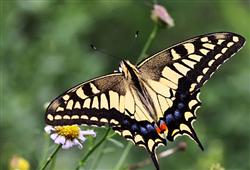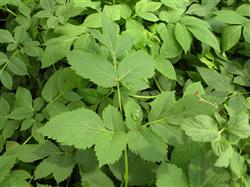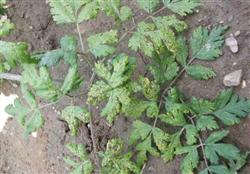What is Sclerotinia sclerotiorum? How to prevent and cure?

What is Sclerotinia sclerotiorum? How to prevent and cure? Please introduce Sclerotinia sclerotiorum, the pathogen of Sclerotinia sclerotiorum is ascomycete subphylum. The sclerotia is placed on the aerial hyphae on the surface of the plant or on the inner cavity of the plant organs, which is like mouse dung, irregular and composed of hyphae. 1. Harmful symptoms: mainly harmful to roots and leaves. At the beginning of the disease, the leaves turned yellow, at the later stage, the plant wilted, the root tissue rotted into a cavity, which contained a number of black mouse fecal sclerotia. 2. The law of disease: the pathogen overwintered with sclerotia in seeds, diseased seedlings, diseased bodies or soil, formed ascospores from December to February-March of the following year, produced ascospores, scattered by wind and rain, and expanded the damage. The bacteria is a low-temperature disease, low temperature and high humidity, many weeds, extensive management is conducive to the disease. 3. Control measures ① focused on removing sclerotia from burned plants and soil to eliminate the source of the disease. ② rotation of flood and drought to eliminate sclerotia in soil. ③ established a disease-free seedling base, selected disease-free seedlings for transplanting, soaked in 0.05% Dysenamine for 10 minutes before transplanting, and disinfected the seedlings. In the early stage of ④, the diseased plants were pulled out in time, the diseased soil was dug out and disinfected with quicklime to prevent the disease from spreading. At the initial stage of ⑤, 65% Dysen zinc or Bordeaux solution was sprayed or irrigated with 300 times sclerotiorum. Click to get more Angelica planting technology click to get more medicinal material planting technology
- Prev

What kind of growing environment is Angelica sinensis suitable for?
What kind of growing environment is Angelica sinensis suitable for? Please introduce Angelica as an alpine plant, which requires cool and humid climatic conditions, and has the characteristics of being fond of fertilizer, afraid of waterlogging and high temperature. when cultivated in areas with low elevations, it is not easy to pass the summer, and the temperature is too high to die. The seeds germinated well in the range of 10-25 ℃ and emerged in 10-15 days. When.
- Next

What is Angelica brown spot? How to prevent and cure?
What is Angelica brown spot? How to prevent and cure? Please introduce that the pathogen of brown spot disease of Angelica sinensis is a fungus of the genus Cercospora. Conidia orbicular, conidia linear to needle-shaped, colorless, transparent, upright or slightly curved, most apical slightly pointed, 1 Mel 3 septum. The main results are as follows: 1. the harmful symptom is harmful leaves. Send it.
Related
- Fuxing push coffee new agricultural production and marketing class: lack of small-scale processing plants
- Jujube rice field leisure farm deep ploughing Yilan for five years to create a space for organic food and play
- Nongyu Farm-A trial of organic papaya for brave women with advanced technology
- Four points for attention in the prevention and control of diseases and insect pests of edible fungi
- How to add nutrient solution to Edible Fungi
- Is there any good way to control edible fungus mites?
- Open Inoculation Technology of Edible Fungi
- Is there any clever way to use fertilizer for edible fungus in winter?
- What agents are used to kill the pathogens of edible fungi in the mushroom shed?
- Rapid drying of Edible Fungi

